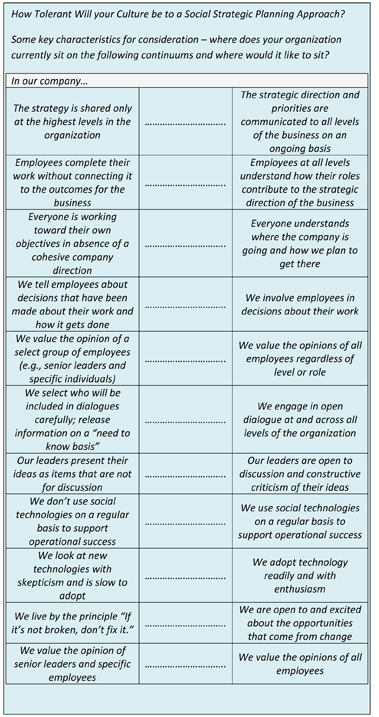Strategic Planning in the Social Sphere
By Kyla Nicholson, CHRP
In The Social Side of Strategy (McKinsey Quarterly May 2012) Gast and Zanini discuss the variety of ways that progressive companies are opening up their strategic planning processes to the broader workforce using social technologies.
Whether it’s having an open dialogue about where the company should go and how it should get there, providing feedback on proposed directions and new products, ranking priority areas for action, or discussing the practicalities of implementation, tools such as wikis, polling systems, and internal idea markets are supporting organizations to engage with their mid-level management and frontline workforces. This engagement has the potential to improve the quality (and practicality) of the organization’s strategy, and to generate enthusiasm and alignment within the workforce. In fact, those are the exact results that these companies are experiencing.
What role is there for HR to play in this new type of “social” strategic planning?
We have heard for years that HR has strived to get to the boardroom table – will that table still exist in the social sphere? Ultimately yes, but the way that the players at that table approach strategic planning, congregate in dialogue, and come to their decisions is evolving.
HR has key roles to play in:
- assessing the opportunity to evolve the strategic planning process;
- defining the roles and behaviours that are required to ensure success;
- responding to HR related concerns / ideas regarding the implementation of strategies priorities; and
- measuring the resulting impact of the changes to the planning process.
What Will the Company Culture Tolerate?
Imagine opening your strategic planning process up to your workforce using exciting new online technologies…and “hearing” deafening silence in response. In some companies, the prevailing culture is one that may not be conducive to a radical social approach to strategic planning. If your culture is one in which people work within strict silos toward their own objectives, people “hold their cards close to their chests”, people don’t speak openly against the ideas of management, or people are slow adopters of technology, introducing a social approach to strategic planning without the appropriate plan in place is likely to result in failure.
HR is often looked to as the culture expert in organizations. Thus, there is an opportunity for HR to take a leadership role in identifying what the current culture is and, based on this, to assess its tolerance for evolving the strategic process to the social sphere.
 Assessing your culture’s readiness for “social” strategic planning can be determined through a variety of means ranging from employee surveys, to focus groups, to structured observations. The assessment should take into account both an assessment of the current state and the desired future state along a variety of dimensions including the strategic alignment, communication style, leadership style, technology adoption, and approach to change.
Assessing your culture’s readiness for “social” strategic planning can be determined through a variety of means ranging from employee surveys, to focus groups, to structured observations. The assessment should take into account both an assessment of the current state and the desired future state along a variety of dimensions including the strategic alignment, communication style, leadership style, technology adoption, and approach to change.
Once there is an understanding of your organization’s tolerance level for taking a more community-based approach to strategic planning, HR has the ability to identify opportunities within the strategic planning process to either shift to the use of social technology, or to enhance the process with the use of social technology. While some organizations might be ready to have an open online dialogue about new markets and products for the company to explore, others might prefer to have those discussions at the executive table and then to present their outcomes to the broader workforce to support prioritization through polling or “liking” options, or for online feedback related to implementation from a frontline perspective.
Roles & Behaviours
Creating social opportunities, regardless of the scale, does not mean that the social sphere decides the strategy. There are as many bad ideas as there are good ones (some might say more), and the insight and expertise of your senior leaders is required to formalize and lead the plan. Venturing into social strategy isn’t about taking power away from leadership; it’s about empowering and aligning people throughout the business. The role of the executive remains to set and drive the strategy, and the role of the rest of the workforce in strategic planning has the opportunity to evolve. It’s important for HR to identify where roles start and end, and what they encompass (e.g., communication responsibilities) in order to support the management of expectations regarding the strategic planning results.
Further, there is a need for clear identification of the roles and behaviours that will be required to ensure the success of an evolving strategic planning process, and to proactively address those behaviours that may impede the process. HR will have unique insight into these requirements based on their understanding of the company culture and the individual strengths of leaders and key influencers in the organization (garnered through the performance management system). This insight can support the identification and ability to address potential behaviours that may create roadblocks to success (e.g., leaders who may be resistant to constructive criticism in a public forum), and to build the roles and foster the behaviours that ensure success (e.g., identify key influencers on the frontlines who will be open to initiating contributions in an online platform and provide them with a key role in the process).
HR’s Role in Execution
Strategic planning with a social component allows HR to have unique insight from frontline workers into some of the human resources considerations associated with key elements of the strategic plan – whether it’s staffing concerns related to the ability to execute on proposed strategic priorities (e.g., “we don’t have the capacity to make this work”), skill development / resource concerns (e.g., “to make this successful we would need to train a minimum of 10 people on this system”), or exciting new opportunities (e.g., “we could set up a peer-to-peer training network with the office in Alberta to fast track skill development in these key areas”), opening the strategic planning process to the social sphere can give HR critical foresight into the frontline challenges and opportunities that a strategic plan presents; enabling these to be tackled in a proactive way.
Measuring Success
Lastly, HR can play an important role in supporting the organization to measure the success and identify opportunities to continue evolving the process. Key success measures should be determined prior to launching the new / evolved strategic planning process and may include:
- measures of engagement in the process (per cent of those invited to participate who contributed; frequency of contribution, etc.);
- quality of data (per cent of ideas presented to those incorporated in the plan);
- alignment to the plan (e.g., per cent of employees that can identify the organizations strategic priorities, understand how their work links to the company’s strategy); and
- follow through on commitments (e.g., were commitments regarding sharing the plan, communicating the final plan, etc. kept), etc.
Regardless of the degree of social interaction that is involved in the social strategic planning process, HR has a variety of opportunities to play a critical role in not only contributing but in supporting the broader organization to make meaningful contributions.
Kyla Nicholson, CHRP, is an HR consultant specializing in organizational learning, training, and development. She is an ongoing contributor to BC HRMA’s research practice…although only when she is not busy traveling around and enjoying reality television.










